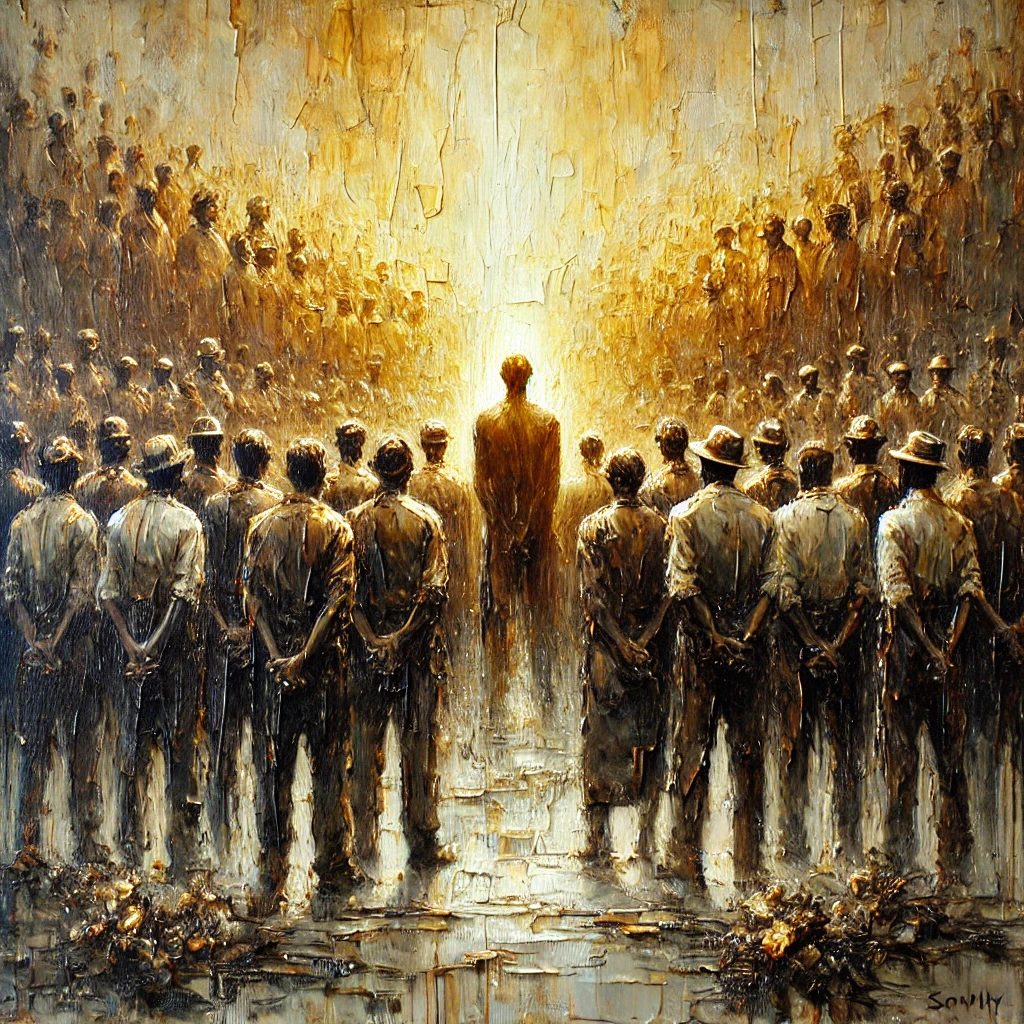Philosophy & Leadership
Broken Promises
The Fall of Soft Power, the Rise of Loud Leadership.
By: Michael Vitaro 🇨🇦
2025-01-26

Broken Promises — The Fall of Soft Power, the Rise of Loud Leadership
The Death of Balance
For decades, leadership has been defined by a delicate balance between persuasion and force. Theodore Roosevelt’s famous maxim, “Speak softly and carry a big stick,” perfectly captures this equilibrium: inspire trust and cooperation through diplomacy, but ensure the ability to act decisively when necessary. This principle, rooted in a blend of influence and strength, became the gold standard for effective leadership in both geopolitics and beyond.
Today, that balance has unraveled. Leadership no longer speaks softly—it stomps loudly, prioritizing force over persuasion. Hard power has taken center stage, displacing the subtle, collaborative strategies of soft power. This shift isn’t arbitrary; it reflects the growing disillusionment with leadership that relies on performance without substance. People have grown weary of promises that fail to deliver and rhetoric that lacks action. In this vacuum, hard power—with its blunt, decisive nature—has rushed in to fill the void.
The failure of soft power lies not in its ideals but in its execution. Its reliance on trust and collaboration crumbles when leaders fail to address the tangible needs of those they serve. The result is a pendulum swing: from the collaborative idealism of soft power to the aggressive pragmatism of hard power. Both approaches, when used in isolation, are flawed. Leadership, whether in geopolitics or corporate boardrooms, cannot succeed without balance.

Soft Power in Action: Promise and Betrayal
Soft power remains a tool of persuasion, rooted in trust and the ability to win hearts and minds without coercion. Its most successful applications have shaped the course of modern history, particularly in the aftermath of World War II, when soft power became the defining strategy for global leadership. However, as its promises continue to go unfulfilled in more recent decades, this once-powerful approach falters, leaving a trail of disillusionment in its wake.
Post-WWII Successes
The years following World War II showcase soft power at its peak. The United States, emerging as a superpower, leveraged economic aid, cultural exports, and democratic ideals to reshape the global order. The Marshall Plan stands as a prime example of this strategy. Through massive economic assistance to rebuild war-torn Europe, the U.S. not only stabilized their economies but also solidified its alliances. This was not mere altruism—it was a calculated act of soft power, binding Europe to American leadership while countering the influence of the Soviet Union.
Beyond economic aid, U.S. cultural dominance continued to be a hallmark of its soft power. Hollywood films, jazz music, blue jeans, and the promise of the “American Dream” painted a vision of democracy and prosperity that resonated globally. Countries looked to the U.S. not only for material support but as a model of freedom and opportunity. Soft power succeeded because it was backed by substance: economic strength, political stability, and cultural magnetism.
Obama and the Modern Betrayal
In the 21st century, the promise of soft power was reignited by Barack Obama’s presidency. His 2008 campaign, built on the themes of “Hope and Change,” captured the imagination of millions both in the U.S. and abroad. Obama symbolized a return to diplomacy, collaboration, and the belief that leadership could inspire progress without resorting to force. For a time, he became the embodiment of soft power, using rhetoric and ideals to foster unity and trust.
But the reality of Obama’s presidency fell far short of its promise. While his administration achieved notable milestones, such as the Affordable Care Act, these were painfully incremental and often technocratic solutions that failed to address systemic issues. For example, the healthcare reform preserved private insurance interests, rather than overhauling the system to provide universal coverage. Similarly, his administration bailed out Wall Street during the 2008 financial crisis without holding major players accountable, leaving many Americans feeling abandoned while the banks responsible thrived.

Meanwhile, wages stagnate, inequality deepens, and the housing crisis persists. The gap between Obama’s lofty rhetoric and the lived reality of many Americans grows glaring. The hope he inspired gave way to frustration as systemic problems remain unresolved. Instead of ushering in transformative change, his presidency became a symbol of incrementalism—soft power that looks good on the surface but fails to deliver on its deeper promises.
This disillusionment extends beyond Obama. It reveals a broader failure of leadership reliant on soft power. Trust, the cornerstone of soft power, erodes as people see leaders prioritize appearances over outcomes. Symbolic gestures replace tangible progress. On the left, ideological purity and virtue signaling substitute actionable solutions. On the right, this disillusionment paves the way for reactionary populism, as many reject soft power entirely in favor of leaders who promise bold, decisive action.
The betrayal of soft power isn’t just about broken promises; it’s about the inability of leaders to deliver results that matter. This failure has swung the pendulum toward hard power—a shift born out of impatience, cynicism, and the desire for something, anything, that can break the cycle of inaction.
Corporate Failures & Performative Symbolism
In recent decades, corporations have embraced the tools of soft power—branding, cultural narratives, and sustainability messaging—to project an image of ethical leadership and social responsibility. On the surface, these efforts aim to build trust and loyalty among employees, consumers, and investors. However, much of this soft power has proven hollow, riddled with symbolic gestures that fail to translate into meaningful change.
Take, for example, the rise of greenwashing, where companies make exaggerated or misleading claims about their environmental efforts. Sustainability pledges, such as promises to achieve “net zero” emissions, are often accompanied by vague timelines and little accountability. These initiatives, while good for public relations, rarely address the deeper structural changes needed to combat climate change. Similarly, inclusivity campaigns frequently focus on surface-level representation without tackling systemic inequities within corporate hierarchies.
These symbolic gestures succeed in generating headlines and bolstering brand images, but they fail to deliver tangible outcomes for the people they claim to serve. Employees are left feeling disillusioned when promises of diversity, equity, and inclusion amount to little more than tokenism. Consumers grow skeptical when sustainability marketing campaigns mask exploitative labor practices or environmentally destructive supply chains. Over time, the gap between rhetoric and reality erodes trust, leaving corporations vulnerable to backlash.
The Public’s Growing Cynicism
As corporations overpromise and underdeliver, the public has grown increasingly cynical. Employees, once drawn to organizations for their aspirational values, now view corporate messaging with suspicion. Consumers, armed with greater access to information, are quick to call out hypocrisy when brands fail to live up to their stated commitments. Trust, the bedrock of soft power, has worn thin.
Nowhere is this erosion of trust more evident than in the tech sector. Companies like Facebook (now Meta) once positioned themselves as champions of innovation and connectivity, fostering a sense of global community. However, revelations about Facebook’s misuse of behavioral data and its role in spreading misinformation have severely damaged its reputation. The company’s algorithms, designed to maximize engagement, have come under fire for prioritizing profit over societal well-being. This betrayal of soft power—using influence not to enrich but to manipulate—has turned what was once a cultural juggernaut into a symbol of corporate overreach.
The fallout extends beyond Facebook. It reflects a broader trend in corporate leadership: a reliance on soft power that is not backed by genuine accountability or meaningful outcomes. Just as in politics, this disconnect between promise and delivery breeds disillusionment, paving the way for louder, harder, and more forceful leadership styles to take hold.

The Swing to Hard Power: Geopolitics
As soft power falters on the global stage, many nations have embraced hard power to assert their influence. This shift reflects the growing impatience with the perceived ineffectiveness of soft power in addressing complex challenges and achieving concrete outcomes. Hard power—defined by coercion, force, and economic leverage—has become the tool of choice for nations seeking to project strength and break through stagnation.
Russia is a prime example of this shift. For years, it leveraged military aggression and energy dominance to exert control over its neighbors and bolster its geopolitical standing. From the annexation of Crimea to its ongoing actions in Ukraine, Russia has relied on its military as a blunt instrument of influence. Simultaneously, its control over energy exports allowed it to wield economic power over dependent nations. However, these hard-power tactics have yielded diminishing returns. The West has responded by weaning itself off Russian oil and gas, while sanctions have isolated Russia economically. Its reliance on force has alienated allies and undermined its long-term credibility, leaving it a pariah state with fewer options.
China offers another example of the pendulum swing toward hard power. Initially, its Belt and Road Initiative (BRI) was a hallmark of soft power, using infrastructure investments and cultural diplomacy to expand its influence across Asia, Africa, and beyond. However, as the BRI faltered—riddled with accusations of debt-trap diplomacy and unsustainable projects—China increasingly shifted to more coercive tactics. Economic dependency on Chinese loans has been coupled with military assertiveness in the South China Sea and a vast surveillance state domestically. While these hard-power strategies demonstrate strength, they come at the cost of soft-power credibility, alienating nations that once viewed China as a benevolent partner.
Corporate Examples
The swing to hard power is equally evident in corporate leadership, where bold, forceful actions have replaced the soft-power strategies of collaboration and persuasion. In the business world, hard power manifests as rapid decision-making, aggressive restructuring, and the consolidation of control over markets and resources.
Elon Musk has become the quintessential symbol of hard-power leadership in the corporate world. His approach is defined by audacious decisions and unapologetic force. Whether it’s laying off large portions of Twitter’s workforce overnight, aggressively pursuing takeovers, or restructuring companies at breakneck speed, Musk’s leadership style prioritizes results above all else. While this approach has garnered praise for its decisiveness, it has also drawn criticism for alienating employees, disrupting workflows, and sacrificing long-term stability for short-term impact. Musk’s leadership embodies the appeal and risks of hard power: it breaks stagnation but often creates collateral damage.
Amazon similarly exemplifies hard-power dominance in the corporate sphere. The company controls markets through aggressive pricing, relentless optimization of logistics, and opposition to unionization efforts. While Amazon occasionally leverages soft-power messaging—such as climate pledges and sustainability initiatives—these efforts often ring hollow when juxtaposed with its hard strategies. Its market control has made it indispensable to consumers, but its treatment of workers and aggressive business practices reveal the darker side of corporate hard power.
Why Hard Power Appeals
Hard power’s resurgence is driven by its visceral appeal. It feels decisive, bold, and action-oriented, cutting through the inertia and empty promises of soft-power leadership. In geopolitics, hard power provides tangible results—territory claimed, adversaries subdued, and leverage gained. For nations that perceive themselves as losing ground in a multipolar world, hard power offers the illusion of control and progress, even when it sows instability.
In the corporate world, hard power resonates with stakeholders frustrated by stagnation and bureaucracy. Leaders like Musk, with their aggressive, no-nonsense approaches, appeal to a public starved for meaningful action. For consumers, employees, and shareholders alike, force feels like progress—even if it comes at the cost of collaboration, empathy, or sustainability.
Yet the appeal of hard power is not without its risks. It often sacrifices long-term trust and stability for immediate gains. While it may temporarily satisfy the hunger for action, its overuse can alienate allies, destabilize systems, and create deeper fractures that are harder to repair. The swing to hard power may break the cycle of inaction, but it risks creating a new cycle of division and backlash.

The Risks of Hard Power Overreach: Alienation and Instability
The allure of hard power lies in its decisiveness, but its overuse often leads to alienation and instability. Hard power, by its nature, prioritizes force over persuasion, imposing outcomes rather than fostering cooperation. This approach may yield short-term results, but it often creates long-term fractures that are difficult to repair.
On the global stage, Russia exemplifies the dangers of overreliance on hard power. Its military aggression and energy dominance initially seemed to strengthen its geopolitical position, but these tactics have ultimately backfired. The annexation of Crimea and the ongoing war in Ukraine have led to widespread condemnation, economic sanctions, and isolation from the global community. European nations, once dependent on Russian oil and gas, have rapidly diversified their energy sources, undermining Russia’s leverage. The backlash has left Russia increasingly isolated, with fewer allies and diminished influence. Its reliance on hard power has destabilized not only its relationships but also its own economy, demonstrating the unsustainable nature of such tactics.
In the corporate world, Elon Musk’s leadership style highlights the risks of alienating key stakeholders. Musk’s aggressive decision-making, such as mass layoffs at Twitter and public disputes with critics, has garnered significant backlash. While his bold actions appeal to those seeking rapid change, they also create instability within his organizations. Employees feel disposable, investors grow wary, and the public questions the sustainability of his approach. The alienation of key stakeholders erodes trust and loyalty, making it harder to sustain long-term success.
Whether in geopolitics or business, hard power creates an environment where fear replaces trust. When leaders impose their will without collaboration, they risk alienating those they rely on, ultimately undermining their own position.
Restoring Balance: A New Leadership Imperative
The failures of both soft and hard power, when used in isolation, underscore the need for a new kind of leadership—one that integrates the best aspects of both approaches. Effective leadership must balance trust-building and empathy with decisiveness and action, forging a path that unites persuasion and strength to address complex challenges.
Theodore Roosevelt’s maxim, “Speak softly and carry a big stick,” offers timeless wisdom for this balanced approach. Roosevelt understood that influence and force are not opposing forces but complementary tools. His leadership combined diplomacy and pragmatism, leveraging America’s emerging strength without alienating its allies. The Marshall Plan serves as a model for how this balance can be achieved. By pairing economic aid with the promotion of democratic ideals, the United States rebuilt Europe after World War II, restoring stability while strengthening its global influence. This was leadership that inspired trust and delivered results—a blueprint for integrating soft power and hard power effectively.
In today’s fragmented world, the new leadership imperative is clear. Leaders must act decisively to address urgent needs, but they must also rebuild trust and credibility through transparency, accountability, and empathy. This balance is not just desirable—it is necessary for sustainable progress.
A Return to Dignity
At its core, leadership is about serving people’s most fundamental needs. Housing, jobs, stability, and dignity are not luxuries—they are the foundation of a thriving society. Yet, for too long, leaders have neglected these basics, prioritizing ideological battles, symbolic gestures, or authoritarian displays of power. The result has been widespread disillusionment, as people feel increasingly disconnected from the systems that govern their lives.
A return to dignity must be the cornerstone of leadership moving forward. People want more than action—they want leadership that respects their needs and delivers tangible solutions. This means addressing the housing crisis, ensuring access to fair-paying jobs, and creating systems that promote stability and opportunity. Without these basics, no amount of rhetoric or force will restore trust or confidence.
Leaders who fail to prioritize these fundamentals—whether through performative soft power or reckless hard power—will ultimately fail. Performative leadership alienates the public by appearing disconnected from reality, while heavy-handed leadership risks backlash by undermining trust. Both approaches are unsustainable in the long term.
To restore balance, leaders must recognize that dignity is not a secondary concern—it is the foundation of legitimacy and trust. By integrating the empathy and vision of soft power with the decisiveness and results of hard power, leadership can deliver real, lasting change. This is not a return to the status quo but a call for leadership that respects human needs while taking bold, decisive action to meet them.